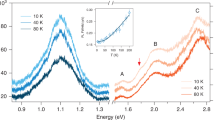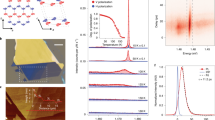Abstract
Bulk chromium tri-iodide (CrI3) has long been known as a layered van der Waals ferromagnet1. However, its monolayer form was only recently isolated and confirmed to be a truly two-dimensional (2D) ferromagnet2, providing a new platform for investigating light–matter interactions and magneto-optical phenomena in the atomically thin limit. Here, we report spontaneous circularly polarized photoluminescence in monolayer CrI3 under linearly polarized excitation, with helicity determined by the monolayer magnetization direction. In contrast, the bilayer CrI3 photoluminescence exhibits vanishing circular polarization, supporting the recently uncovered anomalous antiferromagnetic interlayer coupling in CrI3 bilayers2. Distinct from the Wannier–Mott excitons that dominate the optical response in well-known 2D van der Waals semiconductors3, our absorption and layer-dependent photoluminescence measurements reveal the importance of ligand-field and charge-transfer transitions to the optoelectronic response of atomically thin CrI3. We attribute the photoluminescence to a parity-forbidden d–d transition characteristic of Cr3+ complexes, which displays broad linewidth due to strong vibronic coupling and thickness-independent peak energy due to its localized molecular orbital nature.
This is a preview of subscription content, access via your institution
Access options
Access Nature and 54 other Nature Portfolio journals
Get Nature+, our best-value online-access subscription
$29.99 / 30 days
cancel any time
Subscribe to this journal
Receive 12 print issues and online access
$209.00 per year
only $17.42 per issue
Buy this article
- Purchase on Springer Link
- Instant access to full article PDF
Prices may be subject to local taxes which are calculated during checkout




Similar content being viewed by others
References
Dillon, J. F. & Olson, C. E. Magnetization, resonance, and optical properties of the ferromagnet CrI3. J. Appl. Phys. 36, 1259–1260 (1965).
Huang, B. et al. Layer-dependent ferromagnetism in a van der Waals crystal down to the monolayer limit. Nature 546, 270–273 (2017).
Mak, K. F. & Shan, J. Photonics and optoelectronics of 2D semiconductor transition metal dichalcogenides. Nat. Photon. 10, 216–226 (2016).
Xu, X., Yao, W., Xiao, D. & Heinz, T. F. Spin and pseudospins in layered transition metal dichalcogenides. Nat. Phys. 10, 343–350 (2014).
Schaibley, J. R. et al. Valleytronics in 2D materials. Nat. Rev. Mater. 1, 16055 (2016).
Snoek, J. L. New Developments in Ferromagnetic Materials (Elsevier, New York, 1947).
Tsubokawa, I. On the magnetic properties of a CrBr3 single crystal. J. Phys. Soc. Jpn 15, 1664–1668 (1960).
Wachter, P. The optical electrical and magnetic properties of the europium chalcogenides and the rare earth pnictides. CRC Crit. Rev. Solid State Sci. 3, 189–241 (1972).
Baltzer, P. K., Lehmann, H. W. & Robbins, M. Insulating ferromagnetic spinels. Phys. Rev. Lett. 15, 493–495 (1965).
Furdyna, J. K. Diluted magnetic semiconductors. J. Appl. Phys. 64, R29–R64 (1988).
Ohno, H., Munekata, H., Penney, T., von Molnár, S. & Chang, L. L. Magnetotransport properties of p-type (In,Mn)As diluted magnetic III-V semiconductors. Phys. Rev. Lett. 68, 2664–2667 (1992).
Ohno, H. et al. Ga,Mn)As: A new diluted magnetic semiconductor based on GaAs. Appl. Phys. Lett. 69, 363–365 (1996).
Dillon, J. F., Kamimura, H. & Remeika, J. P. Magneto-optical properties of ferromagnetic chromium trihalides. J. Phys. Chem. Solids 27, 1531–1549 (1966).
Burch, K. S., Awschalom, D. D. & Basov, D. N. Optical properties of III-Mn-V ferromagnetic semiconductors. J. Magn. Magn. Mater. 320, 3207–3228 (2008).
Miles, P. A., Westphal, W. B. & Von Hippel, A. Dielectric spectroscopy of ferromagnetic semiconductors. Rev. Mod. Phys. 29, 279–307 (1957).
Dietl, T. & Ohno, H. Dilute ferromagnetic semiconductors: Physics and spintronic structures. Rev. Mod. Phys. 86, 187–251 (2014).
Gong, C. et al. Discovery of intrinsic ferromagnetism in 2D van der Waals crystals. Nature 546, 265–269 (2017).
Lee, J.-U. et al. Ising-type magnetic ordering in atomically thin FePS3. Nano Lett. 16, 7433–7438 (2016).
Grant, P. M. & Street, G. B. Optical properties of the chromium trihalides in the region 1-11 eV. Bull. Am. Phys. Soc. II 13, (1968).
Pollini, I. & Spinolo, G. Intrinsic optical properties of CrCl3. Phys. Status Solidi 41, 691–701 (1970).
Bermudez, V. M. & McClure, D. S. Spectroscopic studies of the two-dimensional magnetic insulators chromium trichloride and chromium tribromide—I. J. Phys. Chem. Solids 40, 129–147 (1979).
Nosenzo, L., Samoggia, G. & Pollini, I. Effect of magnetic ordering on the optical properties of transition-metal halides: NiCl2, NiBr2, CrCl3, and CrBr3. Phys. Rev. B 29, 3607–3616 (1984).
Figgis, B. N. & Hitchman, M. A. Ligand Field Theory and its Applications (Wiley, New York, 2000).
Tongay, S. et al. Defects activated photoluminescence in two-dimensional semiconductors: interplay between bound, charged, and free excitons. Sci. Rep. 3, 2657 (2013).
McIntyre, J. D. E. & Aspnes, D. E. Differential reflection spectroscopy of very thin surface films. Surf. Sci. 24, 417–434 (1971).
Henderson, B. & Imbusch, G. F. Optical Spectroscopy of Inorganic Solids (Clarendon, Oxford, 1989).
Li, Y. et al. Measurement of the optical dielectric function of monolayer transition-metal dichalcogenides: MoS2, MoSe2, WS2, and WSe2. Phys. Rev. B 90, 205422 (2014).
Shinagawa, K., Sato, H., Ross, H. J., McAven, L. F. & Butler, P. H. Charge-transfer transitions in chromium trihalides. J. Phys. Condens. Matter 8, 8457 (1996).
McAven, L. F., Ross, H. J., Shinagawa, K. & Butler, P. H. The Kerr magneto-optic effect in ferromagnetic CrBr3. J. Phys. B At. Mol. Opt. Phys. 32, 563 (1999).
McGuire, M. A., Dixit, H., Cooper, V. R. & Sales, B. C. Coupling of crystal structure and magnetism in the layered, ferromagnetic insulator CrI3. Chem. Mater. 27, 612–620 (2015).
Malitson, I. H. Refraction and dispersion of synthetic sapphire. J. Opt. Soc. Am. 52, 1377–1379 (1962).
Acknowledgements
The authors thank D. Gamelin for insightful discussions on the optical response of CrI3, and A. Majumdar for testing the measurement system. Work at the University of Washington was mainly supported by the Department of Energy, Basic Energy Sciences, Materials Sciences and Engineering Division (DE-SC0018171), and University of Washington Innovation Award. Work at MIT has been supported by the Center for Integrated Quantum Materials under NSF grant DMR-1231319 as well as the Gordon and Betty Moore Foundation’s EPiQS Initiative through Grant GBMF4541 to P.J.-H. Device fabrication has been partly supported by the Center for Excitonics, an Energy Frontier Research Center funded by the US Department of Energy (DOE), Office of Science, Office of Basic Energy Sciences under Award Number DESC0001088. The contribution of D.H.C. is supported by DE-SC0002197. Work at CMU is supported by DOE BES DE-SC0012509. W.Y. is supported by the Croucher Foundation (Croucher Innovation Award), the RGC of Hong Kong (HKU17305914P), and the HKU ORA. Work at ORNL (M.A.M.) was supported by the US Department of Energy, Office of Science, Basic Energy Sciences, Materials Sciences and Engineering Division. X.X. and D.X. acknowledge the support of a Cottrell Scholar Award. S.G. and L.Y. are supported by NSF grant no. DMR-1455346 and EFRI-2DARE-1542815. X.X. acknowledges the support from the State of Washington funded Clean Energy Institute and from the Boeing Distinguished Professorship in Physics.
Author information
Authors and Affiliations
Contributions
X.X., K.L.S. and P.J.-H. conceived the experiment. K.L.S. built the experimental set-up and carried out the measurements, assisted by D.Z. and B.H., supervised by X.X. Crystal growth, characterization and device fabrication at MIT were carried out by D.R.K. and E.N.-M., supervised by P.J.-H. Device fabrication at UW was carried out by K.L.S., D.Z. and B.H., with crystal grown and characterized by M.A.M. at ONRL. K.L.S. and X.X. analysed and interpreted the data with theoretical support from X.Z., D.X., W.Y., S.G. and L.Y. K.L.S., X.X., D.H.C. and P.J.-H. wrote the manuscript with input from all authors. All authors discussed the results.
Corresponding authors
Ethics declarations
Competing financial interests
The authors declare no competing financial interests.
Additional information
Publisher’s note: Springer Nature remains neutral with regard to jurisdictional claims in published maps and institutional affiliations.
Electronic supplementary material
Supplementary Information
Supplementary notes, Supplementary Figures 1–5, and Supplementary References 1–12
Rights and permissions
About this article
Cite this article
Seyler, K.L., Zhong, D., Klein, D.R. et al. Ligand-field helical luminescence in a 2D ferromagnetic insulator. Nature Phys 14, 277–281 (2018). https://doi.org/10.1038/s41567-017-0006-7
Received:
Accepted:
Published:
Issue Date:
DOI: https://doi.org/10.1038/s41567-017-0006-7
This article is cited by
-
A theory for colors of strongly correlated electronic systems
Nature Communications (2023)
-
Control of magnetic states and spin interactions in bilayer CrCl3 with strain and electric fields: an ab initio study
Scientific Reports (2023)
-
Magneto-optics in a van der Waals magnet tuned by self-hybridized polaritons
Nature (2023)
-
Abnormal thickness-dependent magneto-transport properties of vdW magnetic semiconductor Cr2Si2Te6
npj 2D Materials and Applications (2023)
-
Research progress of two-dimensional magnetic materials
Science China Materials (2023)



